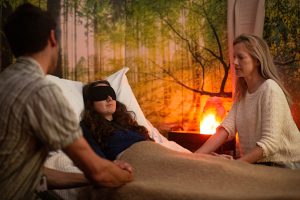Psychedelic Drug Experiences Produce Long-Term Improvements in Psychological Well-Being
By John M. de Castro, Ph.D.
“Awe may be a critically important emotional experience during psychedelic treatment in generating compassion, empathy, and overall well-being” – Eve Ekman
Psychedelic substances such as peyote, mescaline, LSD, Bufotoxin, ayahuasca and psilocybin have been used almost since the beginning of recorded history to alter consciousness and produce spiritually meaningful experiences. People find these experiences extremely pleasant. eye opening, and even transformative. They often report that the experiences changed them forever. Psychedelics have also been found to be clinically useful as they markedly improve mood, increase energy and enthusiasm and greatly improve clinical depression. Even though the effects of psychedelic substances have been experienced and reported on for centuries, only very recently have these effects come under rigorous scientific scrutiny.
In today’s Research News article “Sustained, Multifaceted Improvements in Mental Well-Being Following Psychedelic Experiences in a Prospective Opportunity Sample.” (See summary below or view the full text of the study at: https://www.ncbi.nlm.nih.gov/pmc/articles/PMC8277190/ ) Mans and colleagues recruited adults who were planning on having a psychedelic experience and had them complete a questionnaire before and after the experience and 2 weeks, 4 weeks, and 2 years after measuring well-being, depression, self-esteem, life orientation, emotional stability, meaning in life, acceptance, resilience, mindfulness, social connectedness, gratitude, spiritual transcendence, Spiritual and Religious Attitudes in Dealing with Illness, trust, and compassion and after the experience only Challenging Experience Questionnaire (CEQ), the Mystical Experience Questionnaire (MEQ), and the Emotional Breakthrough.
They found that in comparison to baseline after the psychedelic experiences there were significant improvements in all measures except spirituality that were maintained over follow-up. Factor analysis revealed three clusters of measures labelled as being well, staying well, and spirituality. They found that after the psychedelic experiences there were large significant improvements in being and staying well that were still present 2 years later.
It should be noted that there wasn’t a comparison, control, condition present and that the participants self-selected to engage in psychedelic experiences. Hence, a myriad of confounding alternative explanations for the findings abound, particularly participant expectancy effects (placebo effects). So, great caution must be exercised in drawing conclusions regarding the effects of psychedelic drugs. But placebo effects are generally transitory and don’t last over substantial periods of time and the present improvements lasted for at least 2 years, making it unlikely that confounding variable explanations are viable.
It is interesting that spirituality was not affected as psychedelic drugs have been employed throughout history as a part of spiritual development. It is possible that the context of spiritual ceremony is essential for the effects of psychedelic drugs being interpreted as spiritual effects.
The results of the present study suggest that people who engage in psychedelic experiences have profound improvements in their well-being that are sustained for at least 2 years. The magnitude and duration of the effects may explain why psychedelics have such profound effects on people with mental illnesses producing relief of symptoms and appear to be safe and effective treatments for mental illnesses.
So, psychedelic drug experiences produce long-term improvements in psychological well-being.
“use of psychedelic substances in a naturalistic setting is associated with experiences of personal transformation, a sense of altered moral values, increased feelings of social connectedness, and a more positive mood.” – Matthias Forstmann
CMCS – Center for Mindfulness and Contemplative Studies
This and other Contemplative Studies posts are also available on Google+ https://plus.google.com/106784388191201299496/posts and on Twitter @MindfulResearch
Study Summary
Mans, K., Kettner, H., Erritzoe, D., Haijen, E., Kaelen, M., & Carhart-Harris, R. L. (2021). Sustained, Multifaceted Improvements in Mental Well-Being Following Psychedelic Experiences in a Prospective Opportunity Sample. Frontiers in psychiatry, 12, 647909. https://doi.org/10.3389/fpsyt.2021.647909
Abstract
In the last 15 years, psychedelic substances, such as LSD and psilocybin, have regained legitimacy in clinical research. In the general population as well as across various psychiatric populations, mental well-being has been found to significantly improve after a psychedelic experience. Mental well-being has large socioeconomic relevance, but it is a complex, multifaceted construct. In this naturalistic observational study, a comprehensive approach was taken to assessing well-being before and after a taking a psychedelic compound to induce a “psychedelic experience.” Fourteen measures of well-being related constructs were included in order to examine the breadth and specificity of change in well-being. This change was then analysed to examine clusters of measures changing together. Survey data was collected from volunteers that intended to take a psychedelic. Four key time points were analysed: 1 week before and 2 weeks, 4 weeks, and 2 years after the experience (N = 654, N = 315, N = 212, and N = 64, respectively). Change on the included measures was found to cluster into three factors which we labelled: 1) “Being well”, 2) “Staying well,” and 3) “Spirituality.” Repeated Measures Multivariate Analysis of Variance revealed all but the spirituality factor to be improved in the weeks following the psychedelic experience. Additional Mixed model analyses revealed selective increases in Being Well and Staying Well (but not Spirituality) that remained statistically significant up to 2 years post-experience, albeit with high attrition rates. Post-hoc examination suggested that attrition was not due to differential acute experiences or mental-health changes in those who dropped out vs. those who did not. These findings suggest that psychedelics can have a broad, robust and sustained positive impact on mental well-being in those that have a prior intention to use a psychedelic compound. Public policy implications are discussed.
https://www.ncbi.nlm.nih.gov/pmc/articles/PMC8277190/


